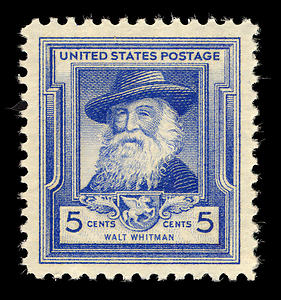
Walt Whitman deemed safe for a U.S. postage stamp in 1948. Public Domain image.
Update Dec. 20, 2010. The ICA (Institute of Contemporary Art) here in Boston is now showing Hide and Seek. See The Boston Globe‘s story: Offensive? ICA Lets Public Decide
School of Theatre director Jim Petosa passed this article on to me. It seems there is an attempt to politicize photographic portraits of Americans of varying sexual and gender expressions in the Smithsonian show, Hide and Seek.
According to the article, a video by artist David Wojnarowicz on his male lover’s death from AIDS, included a scene with ants crawling over a crucifix. The video, A Fire in My Belly, was pulled from the show after complaints from Catholic League president Bill Donahue who called it “offensive.”
An official in incoming House Speaker John Boehner’s office told The Hill newspaper that “Smithsonian officials should either acknowledge the mistake or be prepared to face tough scrutiny beginning in January.”
It seems entirely possible that the overall theme of the show is an underlying reason for the criticism it has received.
Like truth, art challenges and disturbs precisely because it submits to no political agenda or comfortable preconception. At best, art has an adversarial relationship with comfort.
The art world must be a place for everyone with something of worth to say. Sexual orientation and gender expression are not inherently political but are human characteristics. They are “issues” only for those whose political purposes come before the needs of the very people they purport to serve.
Read the full article here including a slide show of some of the works:

One Comment
Jim Petosa posted on December 2, 2010 at 10:57 pm
Thanks for these eloquent words about this critical issue, Benjamin. For those of us who lived through the last intense culture wars against meaningful artistic expression, this is a particularly chilling turn of events. As a College of Fine Arts, we have a leadership role to play in response to this sorry state of affairs. Your words reflect this perfectly.
For interested readers, “Fire in the Belly” is readily available via youtube.com. It is an extraordinary artistic artifact from the height of the AIDS epidemic in 1987. The anger, pain, vulnerability and pathos are palpable. It is rough, but it reflects strong truths. And far from being irreverent, the piece reeks of real emotional and physical pain at the experience of a young life being extinguished. In the wake of this year’s World AIDS Day, it is particularly timely. To see it removed from the National Portrait Gallery exhibit, is a rude awakening.